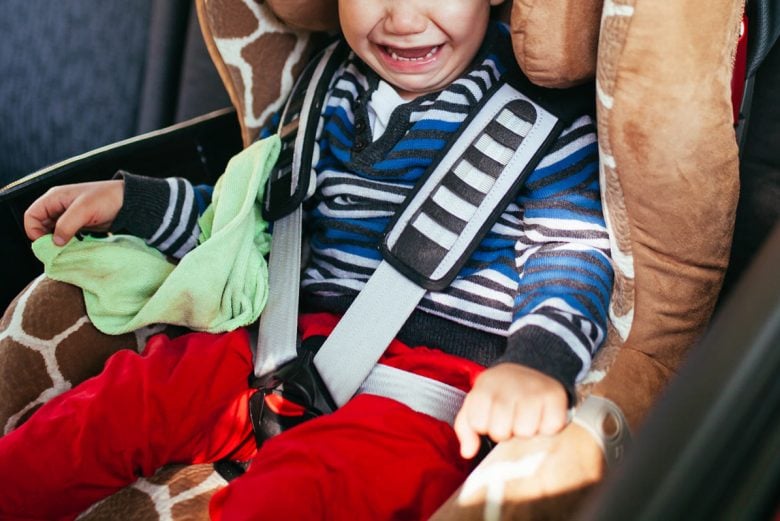
When your child is screaming in the car seat, it’s stressful for everyone.
You want to have an enjoyable experience, but when your child hates her car seat, that feels impossible! You’ve tried all the tricks and distractions you can think of. What else is there to do?
In this episode, Carol & Anne talk about why each Type of child may hate their car seat—it’s not the same for everyone! You’ll learn the best questions to ask yourself, specific to your child’s needs, so you can have a harmonious drive that supports everyone.
This episode’s Parenting Practice
Look at the overall movement of your child and use creative ideas to make the car ride more enjoyable. How can you make it more fun for your Type 1 child? For your Type 2 child, how can they feel more comfortable? If you have a Type 3 child, how could you make it more of a challenge, a practical experience? And finally, for Type 4, how can you reason with them and make it clear for their matter-of-fact minds?
Transcript of podcast episode
Anne: My Type 4 nephew, when he was three-years-old, he would look at the road signs and remind my sister what the speed limit was and she was just like, “I’m so glad he can’t see this speedometer. He would know I was not following the rules!”
Carol: Welcome to “The Child Whisperer” podcast. I’m your host, Carol Tuttle, author of the bestselling parenting book, “The Child Whisperer.” I’m with my co-host, Anne Tuttle Brown.
Anne: “I’m wondering what to do to support my wonderful two and a half-year-old Type 1 daughter. She hates going in her car seat. She will sometimes sit in her seat calmly, but as soon as she gets clicked in, the harness is tightened, she screams and wiggles and pushes her feet against the seat. She has basically hated car seats from the beginning. I’ve had her choose a toy, a stuffed animal, various things to try to keep the car ride fun. Once in the car, it’s a scream fest. She is now avoiding getting in her car seat and it’s become a production to go places and once in, again, is the scream fest. I just want to be able to help her feel comfortable and supported. Any ideas to make going in the car seat fun for her?”
Carol: I think car seats aren’t fun for a Type 1 child so you might have to let her know, this isn’t fun but once we get there, we’re gonna be having all kinds of fun. This is sort of a necessity in life. That might be not so unreasonable. And the fact she’s only two and a half, I don’t know how much you can convey that, but yeah, some things aren’t gonna be fun in life.
Anne: Is it just because of the fact that they’re having to stay still?
Carol: They’re restrictive.
Anne: They restrictive, right.
Carol: Well, this is a pattern now. It’s become her kind of neurological response. It’s her body now, that just triggers this response. Okay. She said it’s been happening her whole life. So, car seats have really developed in their requirements since you were a child, so, I’m curious, what do you do here, Anne?
Anne: We were talking about this question and you’re like, “I don’t remember that.” And I have a home video of me…
Carol: Well, I don’t remember about you kids being freaked out about your car seats.
Anne: Car seats were a very different thing, you know, back in the ’80s.
Carol: They were loose, you could move around, wiggle. I see how some kids are strapped in and it really looks like it could feel like a straight jacket. It’s tight and you don’t move at all. Have you dealt with this?
Anne: When Katie was a baby, my Type 3 daughter, there were points where she was just done being in the car seat and then my Type 2 son, yeah, he gets upset if it’s too tight or he wants to be, like, bigger like his sister so he wants to, like, sit in a booster and not in a car seat. But I’ve tried to, you know, explain to him, like, well, these are the rules and, but then why? Why? Like, I don’t know, just seat in your…
Carol: He’s like the bird in “Finding Nemo.”
Anne: Mine, mine, they say mine but yeah. Why?
Carol: Mine. Mine.
Anne: So, this actually was posted in the Child Whisperer Facebook group and I went on and shared this comment. And you just, like, to find solutions for the Child Whisperer, I always just go back to that, the movement, the keywords. So she said, and she’s doing a couple of things here. You know, she’s trying to make it fun by bringing a stuffed animal, but it sounds like she’s just at her wit’s end and like, what else can I do? So I thought, okay, fun. What’s fun? A game. So I said, “Have you tried making a game? Like, pretending you’re in a rocket ship and you have to go into space to find the magic moon gems. She has to be buckled up because you’re going to go so fast and it’s her job to be on the lookout for red and green colored gems, the stoplights. Pretending and being silly has helped diffuse frustrations with my two-year-old. Try adding an element of play and game and see what happens.”
Carol: It’s the Type 4 mothers rolling her eyes right now. Like, oh, I have to think of all that. It’s just like, car seats keep you safe. Just sit in it.
Anne: Yeah. This is my…honestly, my Type 4 nephew when he was three-years-old. He would look at the road signs and remind my sister what the speed limit was and she was just like, “I’m so glad he can’t see the speedometer. He would know I was not following the rules.” You know he’s like, “Twenty-five, mom, 25, 35, mom.” He is so matter-of-fact and literal.
Carol: Yeah, so a Type 4 child, you say, “Well, the rule is,” you can even look it up on a…and show him on a document.
Anne: Yes, definitely. And like I’ll show you how to do it. Yes. So the parent read the comment, and she tried it, and she gave an update. “We tried the rocket ship yesterday and it was a great success. Thank you. I called the car seat, the command seat, and my daughter was the navigator and would tell me where the moon gems were. My older daughter even played and added an element of finding street signs. So the two of them were finding things constantly and even had some added friendly competition to the game. It was a fun time for all.”
Carol: She’s breaking what’s called in the energy therapy world, she’s breaking state, which means the pattern that’s developed is…over and over and over, is a stressful response when being put in a car seat. Now, that sort of is down at a body level response, now, meaning her own physiology is having this trigger. So she’s breaking state with this game. As she continues to break state, she’s broke the pattern up so that there’s most likely, she’ll get to a place where the car seat now doesn’t have this stressful reference to her system and she’ll just be okay in the car seat.
Anne: And this was actually a couple of months ago, so I reached out to this mom again and she gave us an update after a couple of months of trying this technique.
Carol: But first, let’s take a short break.
Announcer: Knowing your Type and your child’s Type changes everything, doesn’t it? It helps you to understand one another better. It can help your outside too. When you wear clothes that express your Type, you feel better, you look better, and people understand you more easily, including your kids. Carol Tuttle created the Dressing Your Truth program to help you dress true to your Type and create a personal style that expresses who you really are. The best part, you can learn all the basics for free. Start loving how you look and feel at dressingyourtruth.com
Anne: And she said, “Overall she is doing better than she had been, though she still has times of screaming in the car. I continue to try and keep things fun for her, sometimes letting her choose a toy or stuffed animal. She can be distracted away from thinking about being confined in her car seat. She does well. Sometimes it seems nothing will distract though, so we just keep trying.” And in those moments I just say, “She’s not going to be in car seat the rest of her life. Hang on. There’s a season.”
Carol: Yeah. There’s this back and forth like a Type 1 child which show that kind of development where they’re like, okay, it shifted. Oh, no, it’s not, or, okay, it has. Not yet. And I’m happy to see she’s not using food as her incentive because that can be misplayed a lot and now you’re creating issues. Type 1 children were, there’s just a pattern of Type 1 adults developing issues with being overweight because food was…
Anne: Something fun.
Carol: A strong incentive in their childhood to get them to sit still or cooperate and correct a behavior, when food needs to just be, you know, it has its fun place in our lives.
Anne: And in a healthy way. Yeah, definitely.
Carol: Yeah. And I’m not saying you should never use food as an incentive but it can be overused and this is a case where it could have easily been the incentive where she’s using other strategies that work. So she’s disrupting the pattern. She’s breaking it up so that their car seat becomes, yeah, it may be isn’t, I love the car seat, but she’s very tolerant of it then
Anne: So as a Type 2, if you’re having issues with a car seat.
Carol: Make sure the straps — can you get those pads and like furry things.
Anne: Make it comfortable, again, what is a Type 2 incentive that can…
Carol: Get a nice lining and yeah, the touch quality of it that it feels good to the touch. The Type 3, again, that restrictive quality of a car seat can be an issue. So it’s about…
Anne: You could try having like a race, like, see how fast you can get in your car seat. I bet you can’t get it in there before me. Don’t get in your car seat. Don’t get in there, oh, no.
Carol: It seems they’re able to buckle it themselves and manage it and be the person in charge of it. Putting them in charge of their car seat.
Anne: Also sharing with them like the end result, like, we’re headed to grandma’s house. As soon as you get there, you can get out and run around. Or, you know, like, what’s the point of this. And then a Type 4, I think sharing with them the rules or just making it just exactly how they like it. Like, if something’s off, they might feel uncomfortable.
Carol: Yeah, there could be a fit issue.
Anne: They’re very particular about every little bit.
Carol: They’ll notice when some just, they don’t feel right on their body.
Anne: So your parenting practice this week, I know not all of you parents have kids in car seats, but look at how we came to a solution for this, this issue that was going on. Looking at the overall movement, my child needs fun added into this and use your creative ideas. How can we make this more fun? Like, how can we make it a game for Type 2, how do we make it more comfortable? And honestly, I think, like, with my Type 2, even though he’s not a Type 1, games work really well for him because he’s a child. So, you could try that tactic all around and, you know, cater it to their Type. Type 3, what’s the point. Type 4, just make it really clear.
Carol: Yeah, I would do the line, like, Type 1, how can I make it more fun? Type 2, how can I make this more comfortable? Type 3, how can I make this more of a challenge? Like, when they’re even little, like, even at two, two and a half.
Anne: Oh, that’s the best stage. Yeah.
Carol: Let them figure out how to buckle the car seats.
Anne: They’re just thriving to do anything by themselves at that stage.
Carol: Type 4, how can I reason with them? Reason. So you’ve got fun, comfortable, challenging, reason.
Anne: So use your Child Whispering skills to make life easier for yourself and you know to work together with your child to create more harmony.
Carol: And if you haven’t read the book recently, make sure you relisten, reread and…
Anne: Well, that’s where you’ll get all these little ahas and insights and ideas like, oh, that’s what my kid is needing more of, dah, dah, dah. And then you’ll just, you’re creative, you’ll get ideas, you’ll get insights.
Carol: It’s a 420-page book. And thank you for taking time to go on Amazon and leave a review. A five-star review is preferred. Appreciate your support of the book and public spaces online where others read those reviews and determine if it’s a book they feel they can trust and is credible. And there are close to 500, 5-star reviews on “The Child Whisperer.” Thank you.
Anne: Awesome.
Carol: If you’ve not yet done that, we’d really appreciate you sharing your thoughts and a positive review on Amazon.
Thanks for listening. For more support, go to thechildwhisperer.com where you can purchase the book, subscribe to our weekly parenting practice email, and find a transcription and audio of “The Child Whisperer” podcast.
Anne: If you’re listening on Itunes, thank you for leaving your review. If you have a parenting question, please send it to [email protected].



